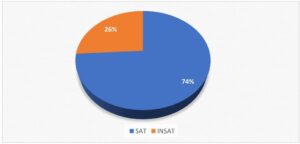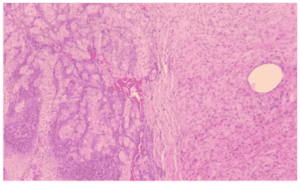ORIGINAL ARTICLE
ROMÃO, Lília Josefa Vidal [1], SILVA, Maria Vanessa da [2], CHAVES, Cintia [3], MEDEIROS, Elizabeth Sampaio de [4], SOARES, Anísio Francisco [5], IMAZAKI, Pedro Henrique Didimo [6]
ROMÃO, Lília Josefa Vidal. et al. Salmonellosis in beef cuts in Brazil. Revista Científica Multidisciplinar Núcleo do Conhecimento. Year 08, Ed. 03, Vol. 02, pp. 134-142. March 2023. ISSN:2448-0959, Access link: https://www.nucleodoconhecimento.com.br/veterinaria-en/salmonellosis, DOI: 10.32749/nucleodoconhecimento.com.br/veterinaria-en/salmonellosis
ABSTRACT
Salmonella are bacteria of paramount importance in the surveillance and inspection of products of animal origin due to their high number of diseases transmitted by food (DTA’s). Through direct contamination, through contact with the feces of men and animals, or indirectly, through fomites, which lead consumers to severe cases of enteritis, which can lead to systemic infection and death. Although in the last 20 years, research and treatments have evolved, the consumption of animal products has also progressed and increased cases. In addition, the irrational use of antibiotics and growth factors brought deleterious effects, where resistance and some difficulty in treatment were perceived. This work aims to carry out a bibliographic review on the current situation of the presence of Salmonella spp. in beef cuts in Brazil. For this, databases were used, such as Portal Capes; Science Direct; Pubmed; Scielo, in the months of December 2022 and January 2023. The data obtained indicate that this bacterium is found in food and is easily transmitted to humans through food intake, such as meat and other contaminated products, due to poor sanitation. . It is understood that in Brazil, salmonellosis continues to be a serious problem for public health, with high death rates and low agribusiness production, as it attracts attention to the development of methods to prevent its proliferation. Therefore, it is concluded that due to its impact on the food security of the population, there is a constant search for improvements in strategies to reduce contamination of Salmonella spp. in Brazil, but continuous deepening is still needed in this area of study.
Keywords: Bacteria, Diarrheal diseases, Meat, Salmonella.
INTRODUCTION
Salmonella spp. it is one of the main causes of diarrheal diseases in the world, one in every four reported cases has the presence of this disease. Annually Salmonella enterica causes about 1.2 million cases of human disease (Valenzuela et al., 2017). The onset of the disease manifestation occurs from 6 to 72 hours after internal contact and can last between 2 and 7 days. In most cases, it can be a mild illness that does not require specific treatment. However, in children and the elderly, it can cause dehydration and put their lives at risk (MINISTRY OF HEALTH, 2022).
Salmonellosis, with its zoonotic potential, is generally transmitted through food, and is present in products such as poultry, pigs and cattle, from primary production to homes and food services. It is found in pets and green vegetables contaminated by manure. Another form of transmission is due to poor personal hygiene, which may occur through the fecal-oral route. And it can still be spread by infected animals that usually do not show symptoms, being just hosts (GOV.BR, 2022).
Salmonella can cause a range of diseases, with severe or mild symptoms, due to its classification in typhoid Salmonella, when it presents systemic enteric fever, and in non-typhoidal Salmonella with less aggressive symptoms, being a self-limited gastroenteritis (NAIR et al., 2019). This differentiation occurs according to the different existing serovars. (GAL-MOR et al., 2014). The best known belonging to two of the most studied subcategories.
Salmonella spp. typhus belongs to a subcategory called specialists/adapters, which infect only specific hosts. In this case, the symptoms are acute and range from high fever, diarrhea, vomiting, headaches and, in extreme cases, death. These serovars are propagated through contamination of water, milk, raw vegetables, marine fish and eggs contaminated with this type of Salmonella spp. (SHINOHARA et al., 2008). In contrast, non-typhoidal Salmonella is known for its generalist serovars, which infect humans and animals and are mainly known for their zoonotic relevance. The symptoms are usually diarrhea, and there is no need for antibiotics. Food of animal origin, such as beef, pork, poultry, ingestion of contaminated raw eggs, and even vegetables and seafood can be vehicles for the dissipation of this disease (GAL-MOR et al., 2014).
Brazil represents one of the greatest powers in beef production in the world, having the second largest commercial herd (ABIEC, 2020). Growing consumption has brought positive points when it comes to the economy, however, the quality of products reduces, which interferes with food health (FRANCIELE et al., 2019). This research aims to carry out a literature review on the presence of Salmonella spp. in Brazilian beef and its effects on the health of the population in order to cover the knowledge on the subject.
METHODOLOGY
The present study comprises a literature, narrative and qualitative review. Where the following databases were used to carry out the research and choose the scientific articles: Scielo, Scopus, Pubmed, Portal Capes and Google academic. The keywords used were “Salmonellosis in Brazil; Salmonellosis in beef cuts”. The manual search was carried out during the months of December 2022 to January 2023. Articles published on the platforms mentioned above, articles in Portuguese and English, were included. articles available in full, articles related to the theme of this research, open access articles, published between 2001 and 2022. The exclusion criteria used were referring to articles with themes that did not apply to the objectives of this research, scientific works in languages other than the Portuguese and English, and citations used in the body of the text and references were duly pointed out.
BIBLIOGRAPHICAL ANALYSIS
MAIN CHARACTERISTICS OF SALMONELLA SPP.
Foodborne diseases (DTA’s) are currently one of the main concerns related to the quality of animal products (RAPOSO et al., 2019). Among the main pathogens of DTA’s are the bacteria of the genus Salmonella, which have a wide worldwide distribution and easy contamination through the consumption of meat, eggs, milk and derivatives, leading to severe cases of enteritis and subsequent sepsis (FRANCIELE et al., 2019). Currently, more than 2,600 serotypes of two different species within the genus have been described: Salmonella bongori and Salmonella enterica (LÖFSTRÖM et al., 2015) and six subspecies called enterica, salamae, arizonae, diarizonae, houtenae and indica (BRASIL, 2011). Among these, the ones with the most reports of infections in humans are Salmonella Typhi and Salmonella Paratyphi, belonging to the enterica subspecies. Subspecies separation is mainly based upon chromosomal DNA hybridization and multilocus enzymatic electrophoresis (YAN et al., 2004).
Salmonella belongs to the Enterobacteriaceae family, gram negative rods, which are capable of forming acid and, most often, gas through the fermentation of glucose. Most of those of clinical interest do not have the ability to ferment lactose, but they can acquire this characteristic through plasmid transfer (BRASIL, 2011). The infecting dose for healthy individuals is 10⁵ to 10⁸, while in immunocompromised people doses lower than 10³ were perceived (FRANCIELE et al., 2019).
The pathogenicity of the disease depends on the ability of these bacteria to enter the non-phagocytic cells of the intestine and proliferate in the lymphoid tissue (Peyer’s patches), leading to disseminated enteritis, which may have access to the mesenteric lymphoid tissues and, systemically, spread to other organs, including spleen and liver (YAN et al., 2004). In the central nervous system, the most common alterations are meningitis, abscesses and subdural empyema and in the other systems endocarditis, osteomyelitis, pleuropneumonia, appendicitis, cholecystitis, renal failure, arthritis, Reiner’s syndrome, among others, are reported (BRASIL, 2011).
For an accurate and quick diagnosis, the stage of the disease, material collected and transport to the laboratory, as well as culture media used for colony growth, must be taken into account. Hemoculture, collection of feces, secretions and cavity fluids or specimens of systemic infections can be performed, but each one has a specificity and sensitivity of the result. It is worth remembering that these tests should not be performed with prior use of antibiotics, which may result in false negatives (GOV.BR, 2022).
Symptomatic supportive treatment, associated with the use of antibiotics, are among the main protocols used, but cases of resistance to these drugs have brought serious concern to medicine (LÖFSTRÖM, 2015).
SALMONELLA SPP IN FOODS
Salmonellosis is one of the main zoonoses, which stands out for its transmitting potential, resistance and pathogenicity of the hosts. Vertical transmission of Salmonella spp. causes severe damage in cattle and poultry, which has major consequences in humans during pregnancy (LIU et al., 2022). Via food, Salmonella spp. has its transmission potential increased by improper hygiene and can occur in the fecal-oral form, with infection occurring through contact with animal or human feces (HANSON et al., 2015). It can be transmitted through contaminated eggs or different types of meat exposed to the bacteria (SUN et al., 2021). And yet the spread of this disease can be increased through contaminated carriers such as rodents and insects (CARTWRIGHT et al., 2015).
Contaminated foods are potential risks for the consumer, since this microorganism is sensitive to certain temperatures, and can be destroyed at temperatures below 60 degrees Celsius, in a low water coefficient, as for example in the pasteurization process where the activity of the water is less than or equal to 0.95 (BRASIL, 2011).
In Brazil, the prevalence of Salmonella spp. in food is not specific, despite leading to a compulsory notifiable pathogenesis, mainly because it is a disease that can lead to mild clinical alterations that have nonspecific signs in some of the unproven cases (FRANCIELE et al., 2019).
CONSUMPTION OF BEEF IN BRAZIL
Brazil represents one of the largest cattle herds in the world, with approximately 212 million head, a figure surpassed only by India, according to the Brazilian Association of Meat Exporters (ABIEC, 2020). Agribusiness accounts for more than 20% of the Gross Domestic Product (GDP) and of this, more than half is being represented by the trade in meat and soy-related products (RODRIGUES et al., 2021). Last year in Brazil the intake of fat from beef was 9.4% of the daily diet. Being higher in males and with equal proportions in urban and rural areas with the highest consumption in the north and midwest of the country (GARZILLO et al., 2022).
People consume meat for different benefits such as satisfaction, health benefits, convenience of purchase and customs or traditions. Customers value certifications on product labels that guarantee their quality, but the language used needs improvement. The use of simple and easy-to-understand messages increases the purchase of certified meat (MAGALHAES et al., 2022).
In the years 2003 and 2008, Carvalho et al. 2014 states that the average daily consumption of red and processed meat was 100 g/day and 113 g/day, respectively. There is an excessive consumption of these cuts in almost 75% of those observed in the research, mainly adolescents and beef has the highest consumption proportion, followed by poultry, pork and fish. Carbon, a reduction in the consumption of beef in Brazil is suggested, but this could reduce the nutritional levels of proteins, iron, zinc and vitamin B12, requiring an increase in the intake of these substances (GARZILLO et al., 2022).
According to a projection developed by Embrapa, by the end of the decade meat production will increase by 23.8%, with beef production specifically increasing by 16.2% and regarding exports, the Department of Agriculture of the United States States, ranks Brazil in 2029 in first place with 28.7% of the total volume, followed by India in second and also the United States and Australia (MALAFAIA et al., 2021).
CONTAMINATION REDUCTION STRATEGIES
In search of new strategies to reduce the spread of this disease, several authors have sought over the years to find effective interventions to mitigate this contamination. Habib et al. (2022), states that the use of Megasphaera elsdenii, a microorganism administered as a probiotic to attenuate ruminal acidosis, has not demonstrated efficacy in reducing Salmonella spp. specifically in the ruminal fluid, but it has some efficiency in reducing the bacteria in cattle feces, contributing to the reduction of contamination in the food chain.
Arthur et al. (2008), states that Salmonella is commonly found in the gastrointestinal tract of ruminants, it does not develop symptoms and is usually eliminated in the manure. And it can still be present in non-mesenteric peripheral lymph nodes, where it cannot be reached through pathogen control interventions. According to Edrington et al. (2020), through experiments with a vaccine, observed a promising result, having a partial effect on peripheral lymph nodes against Salmonella spp.
The industrial meat packaging process can be carried out under vacuum or by controlling the atmosphere of the gases, without any treatment other than cooling to ensure preservation. Correct storage is of paramount importance to maintain the safety and quality of meat components, a poorly done packaging process can lead to the growth and propagation of microorganisms that deteriorate in addition to the development of pathogens, such as salmonella (AYMERICH et al., 2008). In vacuum-packed meats and in a modified atmosphere in 50% CO2 gas the count of Salmonella spp. it may be smaller (DJORDJEVIÉ et al., 2018).
The constant use of antibiotics to treat salmonellosis has further exacerbated the problem, as resistant strains of Salmonella spp. are increasingly common in retail ground meats (WHITE et al., 2001). Therefore, the EFSA (2018) provided measures for the adoption of guidelines for the prudent use of antibiotics in production animals and consequent reduction in the number of pathogens present on farms and slaughterhouses.
FINAL CONSIDERATIONS
Salmonella spp. is a bacterium of great concern, as it can cause great damage to human health, risking life and reducing agricultural production. In addition, controlling its transmission becomes difficult due to its high level of infection, both within the food chain and through vertical contamination. Therefore, it is necessary to continuously study strategies to combat the proliferation of bacteria.
REFERENCES
ARTHUR, T. M.; BRICHTA-HARHAY, D. M.; BOSILEVAC, J. M.; GUERINI, M. N.; KALCHAYANAND, N.; WELLS, J. E.; SHACKELFORD, S. D.; WHEELER, T. L.; KOOHMARAIE, M. Prevalência e caracterização de Salmonella em linfonodos bovinos potencialmente destinados ao uso em carne moída. J Food Prot., vol. 71, 2008. p. 1685–1688.
ASSOCIAÇÃO BRASILEIRA DAS INDÚSTRIAS EXPORTADORAS DE CARNE INDUSTRIALIZADA – ABIEC. Beef Report perfil da pecuária no Brasil 2020 (relatório anual). ABIEC,
2020.
AYMERICH, T.; PICOUET, P. A.; MONFORT, J. M. Tecnologias de descontaminação de produtos cárneos. Meat Science, vol. 78, 2008. p . 114 – 129.
BRASIL. Ministério da saúde. Manual técnico de diagnóstico laboratorial de Salmonella spp..: diagnóstico laboratorial do gênero Salmonella spp. Brasília: Secretaria de vigilância em saúde, 2011.
CARTWRIGHT, E. J.; NGUEYN, T.; MELLUSO, C.; AYERS, T.; LANE, C.; HODGES, A.; LI, X. J.; QUAMMEN, J.; YENDELL, S. J.; ADAMS, J.; MITCHELL, J.; RICKERT, R.; KLOS, R.; WILLIAMS, I. T.; BEHRAVESH, C. B.; WRIGHT, J. A Multistate Investigation of Antibiotic-ResistantSalmonella entericaSerotype I – Infections as Part of an International Outbreak Associated with Frozen Feeder Rodents. Zoonoses and Public Health, v. 63, n. 1, 2015. p. 62–71.
CARVALHO, A. M.; CÉSAR, C. L. G.; FISBERG, R. M.; MARCHIONI, D. M. Meat Consumption in Sao Paulo –Brazil: Trend in the Last Decade. PLoS ONE, v. 9, n. 5, 2014. p. e96667.
DJORDJEVIĆ, J.; BOSKOVIC , M.; STARCEVIC, M.; IVANOVIC, J.; KARABASIL, N.; DIMITRIJEVIC, M.; LAZIÉ, I. B.; BÁLTICA, M. Z. Survival of Salmonella spp.. in minced meat packaged under vacuum and modified atmosphere. Brazilian Journal of Microbiology, v. 49, n. 3, 2018, p. 607–613.
EDRINGTON, T. S.; ARTHUR, T. M.; LONERAGAN, G. H.; GENOVESE, K. J.; HANSON, D. L.; ANDERSON, R. C.; NISBET, D. J. Evaluation of two commercially-available Salmonella spp. vaccines on Salmonella spp. in the peripheral lymph nodes of experimentally-infected cattle. Therapeutic Advances in Vaccines and Immunotherapy, v. 8, 2020. p. 25151355-209577.
FRANCIELE, M. C. Prevalência de infecções causadas por Salmonella spp. no Brasil no período de 2013 a 2017. Journal of Infection Control, vol. 8, n. 2, 2019.
GAL-MOR, O.; BOYLE, E. C.; GRASSL, G. A. Mesma espécie, doenças diferentes: como e por que os sorovares de Salmonella enterica tifóide e não tifóide diferem. Front Microbiol, vol. 5, 2014. p. 1–10.
GARZILLO, J. M. F.; POLI, V. F. S.; LEITE, F. H. M.; MARTINEZ-STEELE, E.; MACHADO, P. P.; LOUZADA, M. L. C.; LEVY, R. B.; MONTEIRO, C. A. Consumo alimentar no Brasil: influência da carne bovina no impacto ambiental e na qualidade nutricional da dieta. Revista de Saúde Pública, v. 56, 2022. p. 102.
HABIB, K.; DROUILLARD, J.; VELOSO, V. A.; HUYNH, G.; TRINETTA, V.; GRAGG, S. E. The Use of Probiotic Megasphaera elsdenii as a Pre-Harvest Intervention to Reduce Salmonella spp. in Finishing Beef Cattle: An In Vitro Model. Microorganisms, v. 10, n. 7, 2022. p. 1400.
HANSON, D. L.; LONERAGAN, G. H.; BROWN, T. R.; NISBET, D. J. M. E.; HUME, M. E.; EDRINGTON, T. S. Evidence supporting vertical transmission of Salmonella in dairy cattle. Epidemiology and Infection, v. 144, n. 5, 2015. p. 962–967.
LIU, B; ZHANG, X; DING, X; BIN, P; ZHU, G. The vertical transmission of Salmonella enteritidis in a One-Health context. One Health, v. 16, 2022. p. 100-469.
LÖFSTRÖM, C.; HANSEN, T.; MAURISCHAT, S.; MALORNY, B. Salmonella: Salmonellosis. DTU Orbit, 2015.
MAGALHAES, D. R.; MAZA, M. T.; PRADO, I. N.; FIORENTINI, G.; KIRINUS, J. K.; CAMPO, M. D. M. An Exploratory Study of the Purchase and Consumption of Beef: Geographical and Cultural Differences between Spain and Brazil. Foods, v. 11, n. 1, 2022. p. 129.
MALAFAIA, G. C.; BISCOLA, P. H. N.; DIAS, F. R. T. Projeções para o Mercado de Carne Bovina do Brasil–2029/2030. Boletim CiCarne, 2021.
MINISTÉRIO DA SAÚDE. Salmonella (Salmonelose). Ministério Da Saúde, 2022. Available in: https://www.gov.br/saude/pt-br/assuntos/saude-de-a-a-z/s/salmonella-salmonelose. Access in: 23 mar. 2023.
NAIR, S.; PATEL, V.; HICKEY, T.; MAGUIRE, C.; GREIG, D. R.; LEE, W.; GODBOLE, G.; GRANT, K.; CHATTAWAYA, M. A. Real-Time PCR Assay for Differentiation of Typhoidal and Nontyphoidal Salmonella. Journal of Clinical Microbiology, v. 57, n. 8. 2019.
RAPOSO, R. S.; DEFENSOR, R. H.; GRAHL, T. R. Uso de probióticos na avicultura para o controle da Salmonella sp..: revisão de literatura e perspectivas de utilização. Pubvet, vol. 13, 2019. p. 152.
RODRIGUES, L. M. S.; MARTA-COSTA, A. A. Competitividade das exportações de carne bovina do Brasil: uma análise das vantagens comparativas. Revista de Economia e Sociologia Rural, 2021. p. 59.
SHINOHARA, N. K. S.; BARROS, V. B.; JIMENEZ, S. M. C.; MACHADO, E. C. L.; DUTRA, R. A. F.; LIMA, J. L. Salmonella spp., importante agente patogênico veiculado em alimentos. Ciência Saúde Coletiva, vol. 13, 2008. p. 1675–1683.
SUN, L.; ZHANG, H.; CHEN, J.; CHEN, L.; QI, X.; ZHANG, R. Epidemiology of Foodborne Disease Outbreaks Caused by Nontyphoidal Salmonella in Zhejiang Province, China, 2010–2019. Foodborne Pathogens and Disease, 2021.
EUROPEAN FOOD SAFETY AUTHORITY AND EUROPEAN CENTRE FOR DISEASE PREVENTION AND CONTROL – EFSA AND ECDC. The European Union One Health 2018. Zoonoses Report. EFSA Journal, v. 17, n. 12, 2018.
VALENZUELA, J. R.; SETHI, A. K; AULIK, N. A; POULSEN, K. P. Antimicrobial resistance patterns of bovine Salmonella enterica isolates submitted to the Wisconsin Veterinary Diagnostic Laboratory: 2006–2015. Journal of Dairy Science, v. 100, n. 2, 2017. p. 1319–1330.
WHITE, D. G.; ZHAO, S.; SUDLER, R.; AYERS, S.; FRIEDMAN, S.; CHEN, S.; MCDERMOTT, P. F.; MCDERMOTT, S.; WAGNER, D. D.; MENG, J. The Isolation of Antibiotic-Resistant Salmonella from Retail Ground Meats. New England Journal of Medicine, v. 345, n. 16, 2001. p. 1147–1154.
YAN, S. S; PENDRAK, M. L.; ABELA-RIDDER, B.; PUNDERSON, J. W.; FEDORKO, D. P.; FOLEY, S. L. An overview of Salmonella typing: public health perspectives. Clinical and Applied Immunology Reviews, vol. 4, n. 3, 2004. p. 189-204.
[1] Master’s student in the Graduate Program in Animal Bioscience. ORCID: 0000-0001-5177-6077. LATTES CURRICULUM: http://lattes.cnpq.br/1598251837568226.
[2] Doctoral student in the Graduate Program in Animal Bioscience. ORCID: 0000-0002-4733-461X. CURRICULUM LATTES: http://lattes.cnpq.br/1906334502843226.
[3] Master in the Graduate Program in Veterinary Science/UFRPE. ORCID: 0009-0006-2998-4164 . LATTES CURRICULUM: http://lattes.cnpq.br/5916608216247980.
[4] Doctor of the Graduate Program in Animal Bioscience. ORCID: 0000-0002-1289-2902. LATTES CURRICULUM: http://lattes.cnpq.br/5998863169551704.
[5] PhD in Biochemistry and Physiology, Master in Physiology, Biologist. ORCID: 0000-0003-1493-7964. LATTES CURRICULUM: http://lattes.cnpq.br/9044747136928972.
[6] Doctor in Veterinary Sciences. ORCID: 0000-0002-1993-0350. CURRICULUM LATTES: http://lattes.cnpq.br/2178390141933805.
Sent: 14th March, 2023.
Approved: 23th March, 2023.



